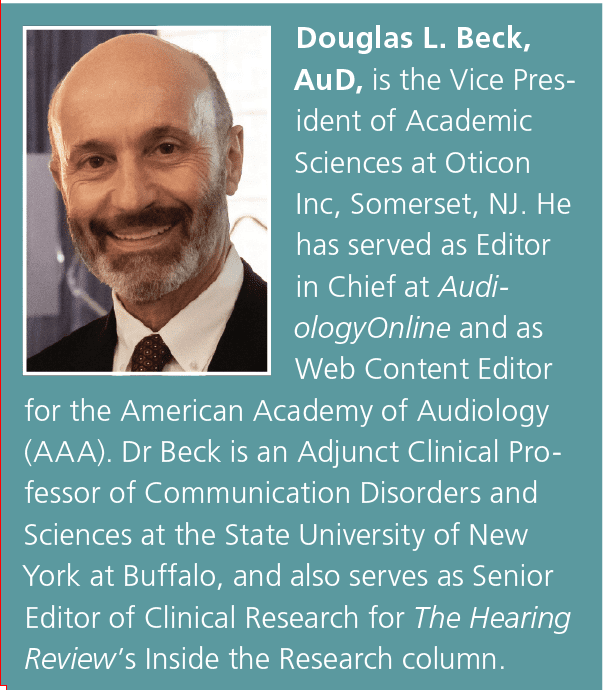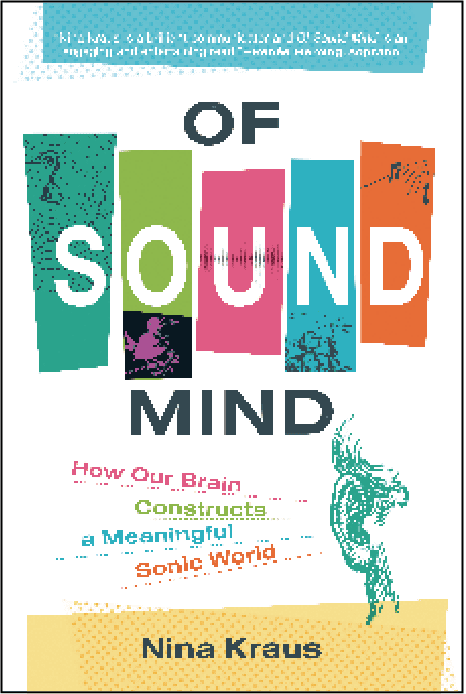Industry Insider | October 2021 Hearing Review
By Douglas L. Beck, AuD
Nina Kraus, PhD, is the Hugh Knowles Professor of Neurobiology in the Department of Communication Sciences and Otolaryngology at Northwestern University in Evanston, Ill. Through her research and those of her colleagues in the Kraus Lab, she has continually uncovered new findings about auditory processing and the brain, as well as our lives in sound—findings that have great consequences for young children and their exposure to music, as well as for people with language disorders, concussion, cognitive issues, hearing loss, and more. Last month, The MIT Press published a wonderful new book by Dr Kraus titled Of Sound Mind.1
Beck: Good morning, Nina! Always a joy to speak with you.
Kraus: Hi Doug!
Beck: The last time we spoke, earlier in 2021, we were in the Oticon Expert Forum2 discussing all aspects of audiology, music, birds, neurophysiology, neuroanatomy, and of course, your new book, Of Sound Mind, which will be released late in September 2021.
Kraus: Yes, that was a fun time!
Beck: And, as The MIT Press is about to release your book, it seems like a good time to discuss some of the ideas and content! However, for those less familiar with you, let me start by noting you earned your bachelor’s degree at Swarthmore College, and your PhD at Northwestern University. Your training was primarily in biology, but you became increasingly interested in neuroscience as the years progressed, and you’ve paid particular attention to the biological underpinnings of auditory learning. Correct?
Kraus: That sounds familiar!
Beck: I hope so! I should note that you are the primary author of content across one my favorite websites, Brainvolts (https://brainvolts.northwestern.edu).3 I urge all professionals to take a look at Brainvolts. The content is brilliant, well organized, contemporary, and includes music, concussion, bilingualism, aging, listening in noise, reading, autism, neuroeducation, technology, and more. I personally use Brainvolts to find a lot of reference materials for my lectures and articles.
Kraus: Thanks Doug. That’s very kind!
Beck: You’re entirely welcome. OK, the new book is a wonderful read! I learned a lot, and I’ll note that the book is more-or-less divided into the introductory issues and topics for those new to the hearing and listening sciences, referred to as “How Sound Works,” and then the lengthier second section is titled “Our Sonic Selves.” The first section deals with sounds outside and inside the head, how we learn and merge auditory signals, and findings about what you call “The Listening Brain: A Quest.” The second section addresses how music is the culmination of multiple sensory and cognitive processes: sensing, meaning, movement, feeling, timing, rhythm, melody, harmony, hearing, and much more. Seriously Nina, your new book was a “page turner” for me. I was very excited to read your thoughts and insights on these issues and to benefit from your explanations of the same.
OK then, so let’s start with acoustic environments which are devoid of sound?
Kraus: Well, as we all know and experience daily, quiet is important and is increasingly rare. We need quiet spaces for our bodies, brains, and emotional well-being. However, in industrialized societies, we’re surrounded by noise. Our central nervous system, and in particular our hearing brain—which I have come to call the “sound mind”—is constantly bombarded by sound.
Beck: And as all hearing care professionals know, according to the Occupational Safety and Health Administration (OSHA), sounds of 90 dBA for 8 hours are likely injurious, and the National Institute of Occupational Safety and Health (NIOSH) states that 85 dB is the red line. So my point is, we do know quite a lot about loud sound and hearing damage, but know a lot less about the impact of lower-level sound.
Kraus: Exactly! Noise (outside and inside the head) impacts brain development, learning, establishing new neurons, signal-to-noise ratio, understanding speech-in-noise, and more. Of course, we can close our eyes when we’re trying to sleep, but our ears are always open and we cannot turn them off. Although we can suppress sounds that are steady-state and relegate them to the background, there is always a relief when the motor of the idling truck nearby is turned off or when the refrigerator stops humming. In many respects, we need and crave quiet time.
Beck: And, in fact, as we develop language and our brains learn to process sounds, we listen to phonemes, words, sentences, and we assign meaning to those learned sounds. As you wrote in the book, learning via sound changes the brain anatomically and physiologically.
Kraus: Yes, the biology is revealing. As we learn to assign meaning to sound, individual neurons in the auditory brain alter their behavior. When a sound has little or no meaning, the brain responds one way, but when the sound represents a meaningful idea, the brain reacts differently. For instance, if we’re sitting at a restaurant, we might try to ignore many sounds, but as soon as the waiter announces the wine and the food specials, we pay more attention. The point is that a “sound-brain” partnership is formed, and it is clearly connected to the living world.
The meaning of the sounds and signals outside the brain matter to the signals inside the brain. Going back to your earlier query, yes, the constant noise and racket makes us numb, perhaps somewhat oblivious, and keeps us from hearing and listening to the detailed, often glorious, information contained within those sounds.
Beck: In the book you mention that we not only hear sounds, but we deeply engage with sounds.
Kraus: Yes! Hearing involves sensing, moving, thinking, and feeling. The typical approach to understanding hearing is a one-way street from the wiggling invisible particles of air to the tympanic membrane, the ossicles, the eighth nerve, the lower and upper brainstem, and finally the temporal lobe…but this is an outdated view. The whole brain is involved in processing sound; it’s not just about detection (ie, audibility and hearing). Simply detecting sound is not enough. We’ve got to be able to detect, de-code, interpret, and apply meaning to the sounds. As you always say, Doug, hearing is perceiving sound, listening is making sense of sound. The whole brain is involved in that, not just the auditory parts. In order to make sense of a sound—say speech—we must synthesize visual signals, emotions, our vocabulary, the rhythm of speech, our knowledge of the person speaking, and the language spoken. Then, all of that comes together, hopefully, to give us a meaningful and correct interpretation of the sounds perceived.
Beck: And, of course, these things happen almost instantly in a normally healthy central nervous system.
Kraus: Yes. Light travels at thousands of miles per second in the natural real world, and the speed of sound is measured in feet per second…so light travels substantially faster than sound. However, the hearing brain operates faster than any other sense. It is the brain’s timing expert.
The interconnectedness of the auditory system within the brain has a dramatic important effect on how we process sound. As we discussed in the Expert Forum, the Hearing Brain is shaped by experience. The sounds we attend to and engage with over the course of a lifetime shape and create the brain we have today—the ever-updating Sound Mind.

See Dr Kraus’ presentation at The Kennedy Center during SoundHealth 2018, found on YouTube at: https://www.youtube.com/watch?v=43I_PHyb_K8.4
Beck: Nina, I’m fascinated with your discussion of the efferent nervous system and how it reacts to sound. Could you spend a minute or two explaining this?
Kraus: Sure. Recognition of the role the efferent nervous system plays in processing sound is a relatively new development. You can think of the efferent system as a “brain-to-ear” network which establishes a “back channel” communication system and acts in tandem with the typical afferent “ear-to-brain” connections. The extent of efferent connectivity increases with evolutionary advancement. The efferent nervous system plays a role in mental flexibility and our propensity to learn. So the efferent system, consisting of input from all of our senses, together with what we know and feel about sound, constantly informs our auditory nervous system. It tunes our afferent auditory processing to make it maximally efficient and effective.
Beck: Further, you go into detail about how we learn what we should pay attention to, whether we’re artists, musicians, engineers, attorneys…we have to intentionally focus on the chosen signal attentively—not passively—to make maximal sense out of all the sensory information.
Kraus: Yes, as we engage with the sounds of our lives, the ability to focus and attend to the chosen signal, while de-emphasizing the “noise” develops. What we choose to pay attention to throughout our lives changes which neurons respond, and how robustly they respond. And, of course, context matters! The Sound Mind works in concert with the limbic, cognitive, sensory, and motor systems to maximize our immediate listening goals, and to enhance learning. It makes us us.
Beck: Thanks Nina. I know we’re out of time, but I want to thank you for your vast contributions to auditory neuroscience and for the learnings you’ve shared with all of us. I absolutely enjoyed reading the book! Not only did it serve as a good basic science review, but it also highlights many of the new and developing frontiers in auditory neuroscience. I am so glad we had a few moments to discuss it!
Kraus: Thanks Doug. I want to mention my partnership with artist Katie Shelly who drew most of the 80 illustrations in the book. There are also a few paintings by Arne Starr. I hope you enjoyed all the personal stories…science is a human endeavor, after all. The book is my answer to the urgent need for all of us to understand how our lives are shaped by sound.
References
- Kraus N. Of Sound Mind. 1st ed. The MIT Press;2021.
- Oticon Inc website. Hearing care professional training and education. https://www.oticon.com/professionals/business-support-services/ training-and-education.
- Brainvolts website. https://brainvolts.northwestern.edu.Published 2021.
- Music and the Mind with Dr Nina Kraus; Soundhealth 2018. Published October 1, 2018. YouTube. https://www.youtube.com/watch?v=43I_PHyb_K8.

CORRESPONDENCE can be addressed to Dr Beck at: [email protected].
Citation for this article: Beck DL. Understanding the sound mind: An interview with Nina Kraus, PhD. Hearing Review. 2021;28(10):30-32.







